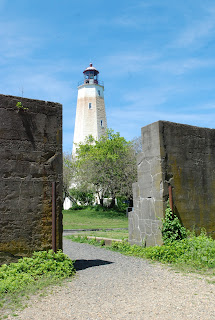 |
| The Sandy Hook Light with the keeper's quarters on the left. |
 |
| Sandy Hool Light from the Mortar Battery |
I really like Sandy Hook, New Jersey. There's water all around except for a narrow strip of land that holds up the road we use to get to the park, lighthouse, and deactivated Fort Hancock. There's a view that features three of New York City's five boroughs, Staten Island, Manhattan, and Brooklyn. Had I lived a hundred years ago, my dream job would have been lighthouse keeper...except for the task of lugging forty-pound buckets of whale oil up ninety-five steps, warming it on a stove, and then carrying it up a ladder to the light. I would have loved the view of New York Harbor, the Atlantic Ocean, and this part of New Jersey, and I would have felt safe and secure living adjacent to Fort Hancock. Yes, it would have been remote, but think of the reading and quilting I would do.
 |
The Lighthouse was built from rubble,
or ballast stones. |
The
Sandy Hook Lighthouse itself is unique. First of all, it was built in 1764, and so it is older than this country itself. The walls are thick as with most lighthouses, but the exterior is not made of bricks. Ballast stones from ships (called 'rubble' in the lighthouse literature) were used to build the walls--with New York being the important port it always was, these stones could have come from anywhere. In 1776, the British occupied the lighthouse on their way to Trenton where the American patriots had the final say. While the British were living in and around the lighthouse, though, the outlook for the patriots' future was looking grim. They desperately tried to destroy the lighthouse to thwart the British, but after an hour of cannonfire it remained undamaged.
 |
| Navesink: Looking at the south Twin Light from the north Light. |
About one hundred years later, the Twin Lights of Navesink were constructed to replace a couple of other lights just south of the Sandy Hook light that were in bad shape. These new lights would further mark the entrance to New York Harbor to make it even safer for ships. When Sandy Hook's brand new first order
Fresnel lens from France didn't fit inside the tower, it was transferred to Navesink and Sandy Hook got a new third order Fresnel which is there to this day. After we climbed the ninety-five steps, we got to stand right next to it, but we were warned not to touch it. It's sharp. That gigantic first-order Fresnel is on display over at the Twin Lights still.
 |
| Close-up of the Sandy Hook third-order Fresnel lens. |
Sandy Hook is a place to revisit any time of year. There are the beaches, a long flat bike path, various Fort Hancock buildings open for touring, a bird observatory, hiking trails, and a neat little (windy) outdoor restaurant called the Sea Gull's Nest. What a glorious place!
 |
| Climbing Sandy Hook: the spiral stairs and red-brick lining were added in the 1860s. |






No comments:
Post a Comment